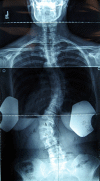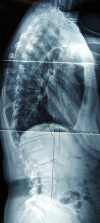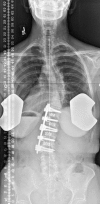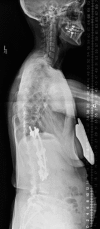Case reports: splenic rupture after anterior thoracolumbar spinal fusion through a thoracoabdominal approach
- PMID: 18546052
- PMCID: PMC2492995
- DOI: 10.1007/s11999-008-0318-0
Case reports: splenic rupture after anterior thoracolumbar spinal fusion through a thoracoabdominal approach
Abstract
The anterior approach in spinal deformity surgery has increased in popularity in recent years. The thoracoabdominal approach to the thoracolumbar spine is associated with numerous possible complications, including injury to vital intraabdominal structures in close proximity to the area of exposure, such as the spleen. We describe the case of a 44-year-old woman who underwent an emergent exploratory laparotomy for progressive abdominal pain and hemodynamic instability that revealed splenic rupture two days after single-stage anterior spinal fusion with instrumentation for thoracolumbar kyphoscoliosis. Because the suspected etiology of the splenic hemorrhage was related to retraction, surgeons using the anterior approach should consider intermittent release of retractors and inspection of intraabdominal structures. Splenic rupture should be considered as part of the differential diagnosis for patients with hemodynamic instability after anterior approaches to the thoracolumbar spine.
Figures





Similar articles
-
Thoracolumbar kyphoscoliosis with unilateral subluxation of the spine and postoperative lumbar spondylolisthesis in Hunter syndrome.J Neurosurg Spine. 2016 Mar;24(3):402-6. doi: 10.3171/2015.6.SPINE15268. Epub 2015 Nov 20. J Neurosurg Spine. 2016. PMID: 26588497
-
Splenic rupture related to thoracoscopic spine surgery.Spine (Phila Pa 1976). 2010 Jun 15;35(14):E654-6. doi: 10.1097/BRS.0b013e3181d290e1. Spine (Phila Pa 1976). 2010. PMID: 20505563
-
Thoracolumbar kyphoscoliotic deformity with neurological impairment secondary to a butterfly vertebra in an adult.Spine Deform. 2020 Aug;8(4):819-827. doi: 10.1007/s43390-020-00050-3. Epub 2020 Feb 5. Spine Deform. 2020. PMID: 32026439
-
[Spontaneous splenic rupture. Case report and literature review].Rev Med Inst Mex Seguro Soc. 2023 Jul 31;61(4):523-531. doi: 10.5281/zenodo.8200591. Rev Med Inst Mex Seguro Soc. 2023. PMID: 37540732 Free PMC article. Review. Spanish.
-
Splenic rupture after colonoscopy. A case report and review of the literature.Chir Ital. 2007 Sep-Oct;59(5):755-7. Chir Ital. 2007. PMID: 18019651 Review.
Cited by
-
Iatrogenic splenic injury: review of the literature and medico-legal issues.Open Med (Wars). 2016 Aug 2;11(1):307-315. doi: 10.1515/med-2016-0059. eCollection 2016. Open Med (Wars). 2016. PMID: 28352813 Free PMC article.
-
Splenic rupture following prone lateral discectomy and arthrodesis: illustrative case.J Neurosurg Case Lessons. 2024 Jul 15;8(3):CASE23639. doi: 10.3171/CASE23639. Print 2024 Jul 15. J Neurosurg Case Lessons. 2024. PMID: 39008909 Free PMC article.
-
Rupture of the spleen following thoracoscopic spine surgery in a patient with chronic pancreatitis.Eur Spine J. 2015 May;24 Suppl 4:S569-72. doi: 10.1007/s00586-014-3724-x. Epub 2014 Dec 13. Eur Spine J. 2015. PMID: 25501876
References
-
- {'text': '', 'ref_index': 1, 'ids': [{'type': 'PubMed', 'value': '15948481', 'is_inner': True, 'url': 'https://pubmed.ncbi.nlm.nih.gov/15948481/'}]}
- Bridwell KH. Indications and techniques for anterior-only and combined anterior and posterior approaches for thoracic and lumbar spine deformities. Instr Course Lect. 2005;54:559–565. - PubMed
-
- {'text': '', 'ref_index': 1, 'ids': [{'type': 'PubMed', 'value': '15308904', 'is_inner': True, 'url': 'https://pubmed.ncbi.nlm.nih.gov/15308904/'}]}
- Christodoulou AG, Ploumis A, Terzidis IP, Timiliotou K, Gerogianni N, Spyridis C. Spleen rupture after surgery in Marfan syndrome scoliosis. J Pediatr Orthop. 2004;24:537–540. - PubMed
-
- {'text': '', 'ref_index': 1, 'ids': [{'type': 'PubMed', 'value': '6826603', 'is_inner': True, 'url': 'https://pubmed.ncbi.nlm.nih.gov/6826603/'}]}
- Hodge WA, DeWald RL. Splenic injury complicating the anterior thoracoabdominal surgical approach for scoliosis: a report of two cases. J Bone Joint Surg Am. 1983;65:396–397. - PubMed
-
- {'text': '', 'ref_index': 1, 'ids': [{'type': 'DOI', 'value': '10.1136/bmj.330.7496.889', 'is_inner': False, 'url': 'https://doi.org/10.1136/bmj.330.7496.889'}, {'type': 'PMC', 'value': 'PMC556163', 'is_inner': False, 'url': 'https://pmc.ncbi.nlm.nih.gov/articles/PMC556163/'}, {'type': 'PubMed', 'value': '15831876', 'is_inner': True, 'url': 'https://pubmed.ncbi.nlm.nih.gov/15831876/'}]}
- Janes SE, Cowan IA, Dijkstra B. A life threatening complication after colonoscopy. BMJ. 2005;330:889–890. - PMC - PubMed
-
- {'text': '', 'ref_index': 1, 'ids': [{'type': 'DOI', 'value': '10.1097/00000658-199805000-00011', 'is_inner': False, 'url': 'https://doi.org/10.1097/00000658-199805000-00011'}, {'type': 'PMC', 'value': 'PMC1191351', 'is_inner': False, 'url': 'https://pmc.ncbi.nlm.nih.gov/articles/PMC1191351/'}, {'type': 'PubMed', 'value': '9605662', 'is_inner': True, 'url': 'https://pubmed.ncbi.nlm.nih.gov/9605662/'}]}
- Pachter HL, Guth AA, Hofstetter SR, Spencer FC. Changing patterns in the management of splenic trauma: the impact of nonoperative management. Ann Surg. 1998;227:708–717; discussion 717–719. - PMC - PubMed
Publication types
MeSH terms
LinkOut - more resources
Full Text Sources

